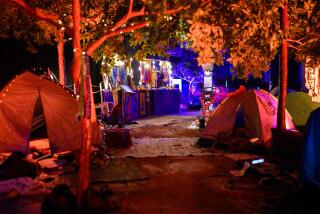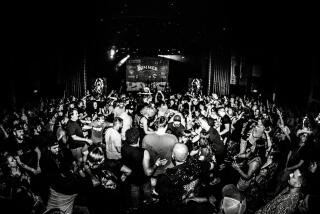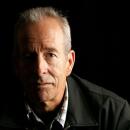One of two women who died of apparent overdose at rave ID’d as UCLA student
Two deaths on the opening night of the Hard Summer music festival in Pomona this weekend have triggered calls for authorities to increase safety measures to prevent such tragedies, especially amid the rapid growth in dance music-oriented festivals.
Los Angeles County Supervisor Hilda Solis called Monday for a temporary ban of raves on county property, similar to one imposed at the L.A. Memorial Coliseum after a teenage girl’s drug death in 2010 at the Electric Daisy Carnival.
Solis said that action the board took at that time was insufficient and that stronger measures are needed now.
“Obviously this is of great concern and very tragic, and I cannot underscore how distraught it is to know two young women are going out to a concert and have to lose their lives thinking they are going to be enjoying themselves.”
The victims, two women, ages 18 and 19, both died from suspected drug overdoses Saturday night, said Lt. Fred Corral of the county coroner’s office. One was identified as 18-year-old Tracy Nguyen of West Covina, who was entering her second year at UCLA. The second victim was not identified pending notification of her family.
Nguyen was majoring in pre-business economics and was known to be an avid dancer. One of her last tweets last month made reference to the concert where she died: “Biggest fear for hard summer: dancing with a guy that can’t keep up with me.”
“We are deeply saddened by the tragic news of Tracy Nguyen’s loss,” UCLA spokesman Tod Tamberg said. “Many students in our UCLA community are grieving her loss. She was a very active and involved student on campus with many friends.
After the 2010 fatality at the Coliseum, a task force created by the county supervisors recommended a series of preventive measures at dance festivals — including ensuring adequate pathways for medical personnel, ample water stations, screening upon entry for drug paraphernalia and illicit drugs, and sufficient security.
Cynthia Harding, the county’s interim public health director, said she did not know whether any of those precautions were in place in Pomona for Hard Summer at the county-owned Fairplex, which is operated by an outside vendor.
Mary Wickham, the interim legal counsel for the county, said officials “are gathering the facts on exactly what was done.” She also said the county is looking closely at the next Hard event scheduled Sept. 10 at the Fairplex. “We will be operating on a timetable to address these issues prior to that date,” she said.
The Hard Summer festival was staged by Live Nation Inc. of Beverly Hills, one of the nation’s largest concert promoters. Live Nation officials declined to comment beyond a statement the company issued saying that one victim suffered from cardiac arrest and the other from possible seizure symptoms.
“Unfortunately, both patrons have passed away,” the statement said. “The cause of death is still under investigation. We extend our deepest sympathies to their families and friends.”
The deaths occurred amid an explosion in the popularity of electronic dance music, or EDM — which has moved into the mainstream from its beginnings in underground clubs and abandoned warehouses.
An estimated 1.4 million tickets were available for EDM festivals last year, a tenfold increase from 2007, according to the International Music Summit, a trade group.
EDM has also taken a larger presence at destination music festivals, notably the Coachella Valley Music and Arts Festival, and is considered the fourth most popular music genre in the U.S., behind R&B and hip-hop, rock and pop, and slightly ahead of country music, according to Nielsen Music’s U.S. Report 2014. Just five years earlier, electronic music ranked 11th among 13 genres.
The dance music scene typically attracts people in their teens and early 20s, and many seek to heighten the effects of the hypnotic, pulsating music with MDMA, a club drug widely known as Ecstasy, or Molly.
In its pure form, the drug has effects of both amphetamines and hallucinogenics, which can increase seratonin, raise body temperatures and reduce sodium levels. When combined with the environment of a hot outdoor music festival, these effects compound the risk of hyperthermia and dehydration, said Sean Nordt, a toxicology expert at USC’s Keck School of Medicine.
“The risks are multi-fold — cash-strapped college students who can’t pay $5 for water, lots of people in tight spaces and events designed for dancing for many hours,” Nordt said. “A lot of times, by the time someone gets to the ER, they’re so far beyond the curve because there’s been a delay in care. A lot of the problem is identifying who is at risk.
Nordt said the risk of tragedies can be reduced by providing resources like abundant free water and calm open spaces, and an environment where music fans know the warning signs of hyperthermia or heatstroke and feel comfortable seeking help for themselves or friends without fear of punishment.
“What I want is for people to be safe, and we should be treating this as a public health issue,” he said. “There needs to be a public health movement about this with education on campuses.”
One factor preventing festival promoters from becoming more proactive with such education is the 2003 Illicit Drug Anti-Proliferation Act, previously called the RAVE Act, said Tammy L. Anderson, a sociology and criminal justice professor at the University of Delaware.
“The problem with the RAVE Act is that it holds the party promoters — the people who throw the event — accountable for anything that could be associated with drug culture,” Anderson said. “They use it as evidence that the promoter knows drug use will happen at the event and condones. So when a promoter allows drug-related educational pamphlets to be distributed at their event, the RAVE Act could possibly read that as, ‘Well, the promoter knows drug use is going to happen at the event’ and is therefore accommodating it.”
Anita Rivas, a Los Angeles lawyer who has represented musicians, promoters and venues in cases stemming from accidents or other mishaps at entertainment events, said Monday that the problem extends far beyond the EDM scene.
“It happens at frat houses, nightclubs and in the homes of their parents. It’s not just concerts and festivals,” she said. “People are going to party — it’s their age and our culture. Young people are far too interested in doing drugs and being wasted. They do not realize the long-term consequences. Regrettably, casualties go with the territory of substance abuse, whether it’s smoking cigarettes or an addiction to prescription drugs.”
Missi Wooldridge, the executive director of the advocacy group DanceSafe, says her group provides on-site testing of narcotics and drug information counseling at various dance music events in the U.S. and Europe. The group doesn’t endorse drugs, she said, but instead tries to make young people aware of the risks and precautions they can take.
“We’re often the first point of contact for that, and more than triage, we need to focus on education and prevention,” Wooldridge said. “Drug use can’t be pushed under the rug any longer.”Times staff writer Todd Martens contributed to this report.
Follow @lacrimes on Twitter.
ALSO:
Immigrants object to growing use of ankle monitors after detention
Girl, 16, dies of wounds suffered in attack on Jerusalem gay pride parade
Hillary Clinton makes a big ad buy targeting voters -- and maybe Joe Biden
More to Read
Sign up for Essential California
The most important California stories and recommendations in your inbox every morning.
You may occasionally receive promotional content from the Los Angeles Times.













